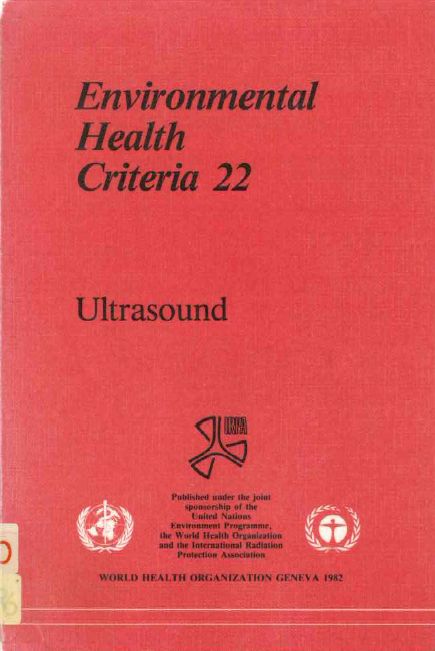EHC 22 on Ultrasound - 1982
ISBN: 92-4-154082-6

Environmental Health Criteria 22: Ultrasound. Geneva: World Health Organization; 1982.
Published under the joint sponsorship of the United Nations Environment Programme, the International Labour Organization, the International Radiation Protection Association (IRPA-INIRC), and the World Health Organization - © WHO, Geneva, 1982.
Excerpt of the preface: "Modern advances in science and technology change man's environment, introducing new factors which, besides their intended beneficial uses, may also have untoward side-effects. Both the general public and health authorities are aware of the dangers of pollution by chemicals, ionizing radiation, and noise, and of the need to take appropriate steps for effective control. The more frequent use of ultrasound in industry, commerce, the home, and particularly in medicine, has magnified the possibiity of human exposure, increasing concern about possible human health effects, especially in relation to the human fetus.
This document comprises a review of data, which are concerned with the effects of ultrasound exposure on biological systems, and are pertinent to the evaluation of health risks for man. The purpose of this criteria document is to provide information for health authorities and regulatory agencies on the possible effects of ultrasound exposure on human health and to give guidance on the assessment of risks from medical, occupational, and general population exposure to ultrasound.
Subjects briefly reviewed include: the physical characteristics of ultrasound fields; measurement techniques; sources and applications of ultrasound; levels of exposure from devices in common use; mechanisms of interaction; biological effects; and guidance on the development of protective measures such as regulations or safe-use guidelines.
In a few countries, concern about occupational and public health aspects has led to the development of radiation protection guidelines and the establishment of equipment emission or performance standards, and limits for human exposure (mainly to airborne ultrasound). Health agencies and regulatory authorities are encouraged to set up and develop programmes which ensure that the lowest exposure occurs with the maximum benefit. It is hoped that this criteria document may provide useful information for the development of national protection measures against non-ionizing acoustic radiation."
Table of Contents
ENVIRONMENTAL HEALTH CRITERIA FOR ULTRASOUND 1. SUMMARY AND RECOMMENDATIONS FOR FURTHER STUDIES 1.1. Summary 1.1.1. Scope and purpose 1.1.2. Introduction 1.1.3. Mechanisms of action 1.1.4. Biological effects 1.1.4.1 Airborne ultrasound 1.1.4.2 Molecules in living systems 1.1.4.3 Cells in suspension 1.1.4.4 Organs and tissues 1.1.4.5 Animal studies 1.1.4.6 Epidemiology and health risk evaluation 1.1.5. Exposure limits and emission standards 1.1.5.1 Occupational exposure to airborne ultrasound 1.1.5.2 Therapeutic use 1.1.5.3 Diagnostic use 1.1.5.4 General population exposure 1.2. Recommendations for further studies 1.2.1. Measurement of ultrasonic fields 1.2.2. Exposure of patients to diagnostic ultrasound 1.2.3. Biological studies 1.2.4. Training and education 1.2.5. Regulations and safety guidelines for equipment 2. PHYSICAL CHARACTERISTICS OF ULTRASOUND 2.1. Continuous, gated, and pulsed waves 2.2. Intensity distribution in ultrasound fields 2.2.1. Progressive wave fields 2.2.2. Standing waves 2.3. Speed of sound 2.4. Refraction and reflection 2.5. Characteristic acoustic impedance 2.6. Attenuation and absorption 2.7. Finite amplitude effects 3. MECHANISMS OF INTERACTION 3.1. Thermal mechanism 3.2. Cavitation 3.2.1. Introduction 3.2.2. Stable cavitation 3.2.3. Transient cavitation and studies concerned with both stable and transient cavitation 3.2.4. Cavitation in tissues 3.3. Stress mechanisms 3.3.1. Radiation pressure, radiation force, and radiation torque 3.3.2. Acoustic streaming 4. MEASUREMENT OF ULTRASOUND FIELDS 4.1. Measurement of liquid-borne ultrasound fields 4.1.1. Measurement of the total power of an ultrasound beam 4.1.2. Spatial and temporal measurements 4.2. Measurement of airborne ultrasound fields 5. SOURCES AND APPLICATIONS OF ULTRASOUND 5.1. Domestic sources 5.2. Industrial and commercial sources 5.2.1. Airborne ultrasound exposure levels 5.3. Medical applications 5.3.1. Diagnosis 5.3.1.1 Exposure levels from diagnostic ultrasound equipment 5.3.2. Therapy 5.3.2.1 Exposure levels from therapeutic ultrasound equipment 5.3.3. Surgical applications 5.3.4. Other medical applications 5.3.5. Dentistry 6. EFFECTS OF ULTRASOUND ON BIOLOGICAL SYSTEMS 6.1. Introduction 6.2. Molecules in living systems 6.3. Cells 6.3.1. Effects on macromolecular synthesis and ultrastructure 6.3.1.1 Protein synthesis 6.3.1.2 DNA 6.3.1.3 Cell membrane 6.3.1.4 Intracellular ultrastructural changes 6.3.1.5 Summary 6.3.2. Effects of ultrasound on mammalian cell survival and proliferation 6.3.3. Synergistic effects 6.3.4. Summary 6.4. Effects on multicellular organisms 6.4.1. Effects on development 6.4.1.1 Drosophila melanogaster 6.4.1.2 Mouse 6.4.1.3 Rat 6.4.1.4 Frog 6.4.1.5 Summary 6.4.2. Immunological effects 6.4.2.1 Summary 6.4.3. Haematological and vascular effects 6.4.3.1 Platelets 6.4.3.2 Erythrocytes 6.4.3.3 Blood flow effect 6.4.3.4 Biochemical effects 6.4.3.5 Effects on the haemopoietic system 6.4.3.6 Summary 6.4.4. Genetic effects 6.4.4.1 Chromosome aberrations 6.4.4.2 Mutagenesis 6.4.4.3 Summary 6.4.5. Effects on the central nervous system and sensory organs 6.4.5.1 Morphological effects 6.4.5.2 Functional effects 6.4.5.3 Auditory sensations 6.4.5.4 Mammalian behaviour 6.4.5.5 The eye 6.4.5.6 Summary 6.4.6. Skeletal and soft tissue effects 6.4.6.1 Bone and skeletal tissue 6.4.6.2 Tissue regeneration - therapeutic effects 6.4.6.3 Muscle 6.4.6.4 Thyroid 6.4.6.5 Treatment of neoplasia 6.4.6.6 Summary 6.5. Human fetal studies 6.5.1. Fetal abnormalities 6.5.2. Fetal movement 6.5.3. Chromosome abnormalities 6.5.4. Summary 7. EFFECTS OF AIRBORNE ULTRASOUND ON BIOLOGICAL SYSTEMS 7.1. Auditory effects 7.2. Physiological changes 7.3. Heating of skin 7.4. Symptomatic effects 7.5. Summary 8. HEALTH RISK EVALUATION 8.1. General 8.1.1. Criteria 8.1.2. Mechanisms 8.1.3. In vitro experimentation 8.2. Diagnostic ultrasound 8.3. Therapeutic ultrasound 8.4. Hyperthermia 8.5. Dental devices 8.6. Airborne ultrasound 8.7. Concluding remarks 9. PROTECTIVE MEASURES 9.1. Regulations and guidelines 9.2. Types of standards for ultrasound 9.2.1. Standards for devices 9.2.1.1 Diagnostic ultrasound 9.2.1.2 Therapeutic ultrasound 9.2.1.3 Other equipment performance standards 9.2.2. Exposure standards 9.2.2.1 Airborne ultrasound 9.3. Specific protective measures 9.3.1. Diagnostic ultrasound 9.3.2. Therapeutic ultrasound 9.3.3. Industrial, liquid-borne and airborne ultrasound 9.3.4. General population exposure 9.4. Education and training REFERENCES APPENDIX I APPENDIX II APPENDIX III
WHO/IRPA TASK GROUP ON ENVIRONMENTAL HEALTH CRITERIA FOR ULTRASOUND
